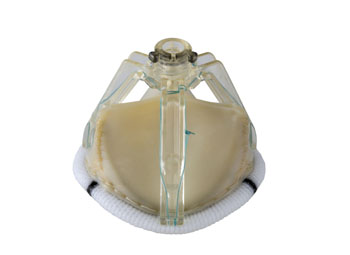New Technology Improves Aortic Valve Replacement Options
By HospiMedica International staff writers
Posted on 27 Apr 2016
Innovative tissue aortic valve delivery technology improves implantation during both minimally invasive and conventional valve replacement procedures.Posted on 27 Apr 2016
The Trifecta aortic valve with Glide Technology (GT) is intended for the treatment of diseased, damaged, or malfunctioning aortic heart valves, with enhanced valve delivery easing implantation in challenging anatomies and surgical approaches, while retaining optimal hemodynamic performance. To reduce wear and deterioration over time, the Trifecta GT valve stent is covered with tissue that improves tissue-to-tissue contact when the leaflets open and close. Additionally, the valve is treated with a proprietary anti-calcification treatment to reduce tissue mineralization.

Image: The SJM Trifecta valve with Glide Technology (Photo courtesy of St. Jude Medical).
The valve leaflets are made of bovine pericardium, overlaid on a fatigue-resistant, radiopaque titanium stent that provides a supportive frame for added durability. The stent covering and valve-sewing cuff are made of polyester, and the tissue stent covering is made of porcine pericardium. The Trifecta aortic valve with Glide Technologyis a product of St. Jude Medical (SJM; St. Paul, MN, USA), and has received the European Community CE mark of approval.
“For years, St. Jude Medical has dedicated significant resources to develop best-in-class heart valve replacement options while refining our devices based on physician feedback and clinical outcomes,” said Philip Ebeling, VP and chief technology officer at SJM. “The improved design of the Trifecta GT tissue valve allows for smoother placement while providing nearly unobstructed blood flow over the life of the valve. The Trifecta GT tissue valve is a true testament to our commitment to the cardiac surgery community and the patients they treat.”
“The excellent hemodynamic performance of the valve improves quality of life by restoring blood flow both at rest and during exercise, making it an outstanding choice for a wide range of patients,” said Professor Alain Leguerrier, MD, of Centre Hospitalier Universitaire de Rennes (France). “The enhancements to the Trifecta GT tissue valve facilitate improved valve parachuting and seating, which means the valve can gently glide into place.”
Aortic valve disease results in dysfunction of the aortic valve, usually as a result of stenosis, which can result in narrowing of the valve opening and a reduction in blood flow. Aortic stenosis is a common problem affecting approximately three percent of the population over age 65, and five percent of people older than 75. From the onset of aortic stenosis symptoms, the average survival rate is 50% at two years and 20% at five years.
Related Links:
St. Jude Medical














